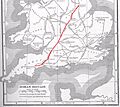List of Roman sites in Lincolnshire facts for kids
This article explores the amazing Roman sites found in Lincolnshire, a county in England. When the Romans were in Britain, they built many towns, roads, and other important places. Lincolnshire was a key area for them, especially because of its location and the important city of Lincoln. Let's discover some of these ancient Roman treasures!
Contents
Roman Towns and Settlements in Lincolnshire
The Romans built many settlements across Lincolnshire. These places were like small towns or forts where people lived, traded, and sometimes soldiers were stationed.
Lincoln: A Roman Powerhouse
The most important Roman site in Lincolnshire was Lincoln, known as Lindum Colonia by the Romans. It started as a strong fortress for the Roman army. Later, it became a "colonia," which was a special type of Roman town where retired soldiers could live. Lincoln was a very important city in Roman Britain.
Other Key Roman Settlements
Many other places in Lincolnshire were also Roman settlements:
- Ancaster: This was a fortified settlement, meaning it had defenses like walls.
- Horncastle: Another fortified settlement, possibly known as Bannovalum.
- Kirmington: This place was built on top of an even older Iron Age settlement, showing people lived there for a very long time.
- Navenby: This settlement was located right on Ermine Street, a major Roman road. People lived here even before the Romans arrived, during the Bronze and Iron Ages.
- Marton: This was a Roman fort, built near the River Trent on Till Bridge Lane.
Important Roman Roads and Canals
The Romans were expert builders, especially when it came to roads and canals. These helped them move soldiers, goods, and people all over Britain.
Major Roman Roads in Lincolnshire
- Ermine Street: This was one of the most important Roman roads in Britain. It connected London all the way to York, passing through many Lincolnshire towns like Stamford, Grantham, Ancaster, and Lincoln. Imagine how busy this road must have been!
- Fosse Way: Another very long Roman road, about 230 miles long! It stretched from Exeter to Lincoln.
- King Street: This road linked Peterborough to Ancaster, going through Bourne and Sapperton.
- Mareham Lane: This road connected Bourne to Sleaford, and possibly even further north to Lincoln.
Roman Canals: Waterways for Trade
- Car Dyke: This was a huge Roman canal, about 85 miles long! It ran along the western edge of The Fens, a flat, marshy area. It was likely used for transport and drainage.
- Foss Dyke: Built around 120 AD, this canal connected Lincoln to Torksey on the River Trent. It helped move goods to and from Lincoln by water.
Roman Buildings and Structures
Beyond towns and roads, the Romans left behind many other interesting structures, from grand villas to city walls.
Roman Villas: Country Homes
Roman villas were like large country houses, often owned by wealthy Romans or important local people. Many have been found in Lincolnshire:
- Denton Villa: Located in Denton.
- Glentworth Hall Villa: Found in Glentworth.
- Horkstow Villa: This villa was in Horkstow.
- Winterton Villa: A significant villa discovered in Winterton.
Lincoln's Roman Features
The city of Lincoln still has many visible signs of its Roman past:
- Newport Arch: This is an amazing Roman gate in Lincoln. It's thought to be the oldest arch in the United Kingdom that is still used by traffic today! It was built in the 3rd century.
- East Gate: Another gate in Lincoln, part of the city's defenses.
- Mint Wall: This is a surviving part of a large Roman building in Lincoln, possibly a basilica (a public building for meetings or law courts).
- City Walls: You can still find fragments of the original Roman city walls throughout Lincoln, showing how well-built they were.
- Forum: In the heart of Roman Lincoln, there was a forum, which was a public square. Today, granite stones in the ground mark where the columns of the forum once stood.
- Castellum Aquæ: This was a Roman water tank, part of the city's water supply system.
- Well: A Roman well in Lincoln, near St Paul in the Bail, was used until the 17th century and is now covered by a glass screen so you can see it.
- St Paul in the Bail: This site in Lincoln was home to a church built in the 4th century, showing early Christian activity in Roman Britain.
Other Notable Structures
- Horncastle Town Wall: Like Lincoln, Horncastle also had Roman town walls, and you can still see parts of them today.
- Lead Coffin: A Roman lead coffin was found in the churchyard at Baumber in 1892, giving us a glimpse into Roman burial practices.
- Gravestone: A Roman gravestone was found in Lincoln, reused by the Danes much later. It's now part of a Norman church wall.
Images for kids



















